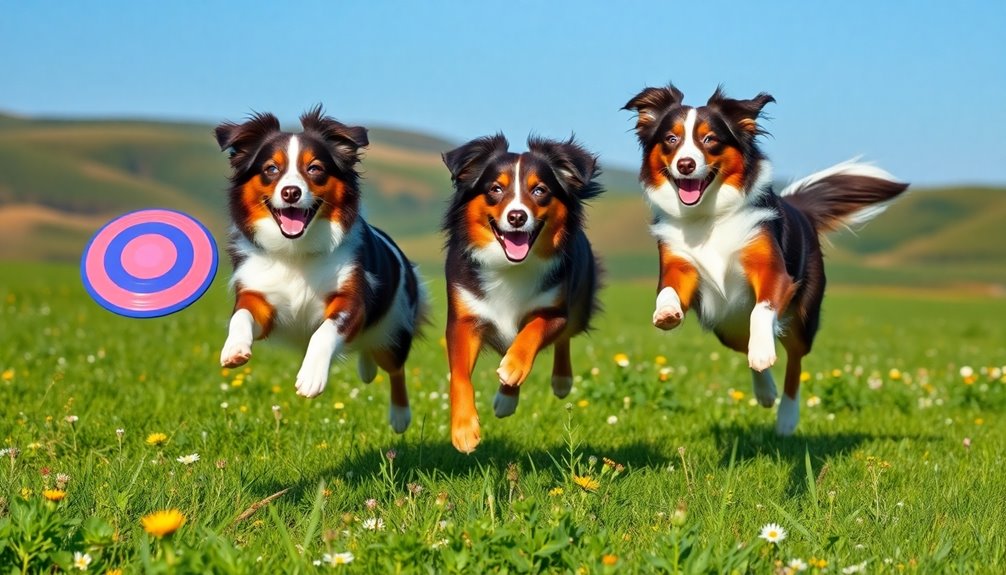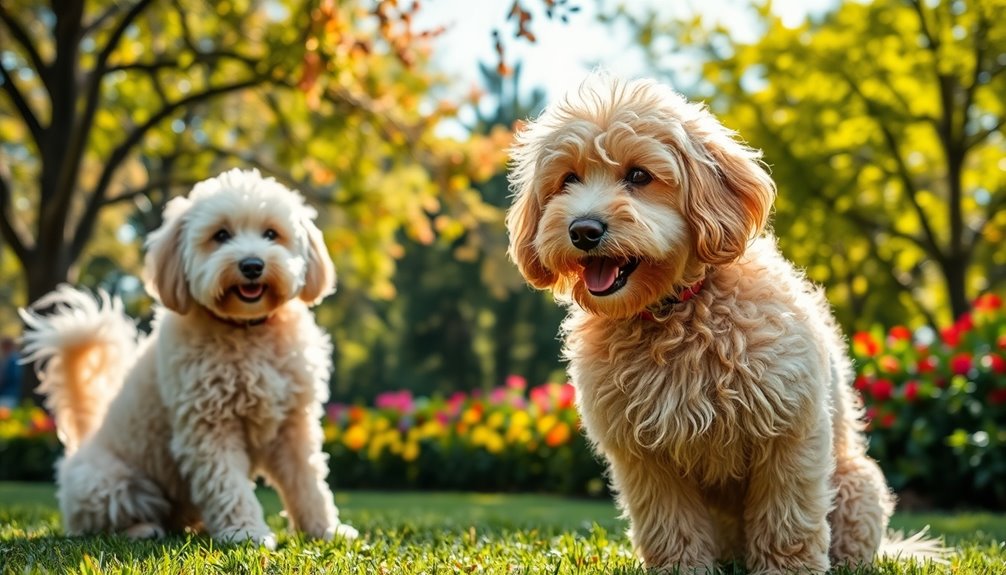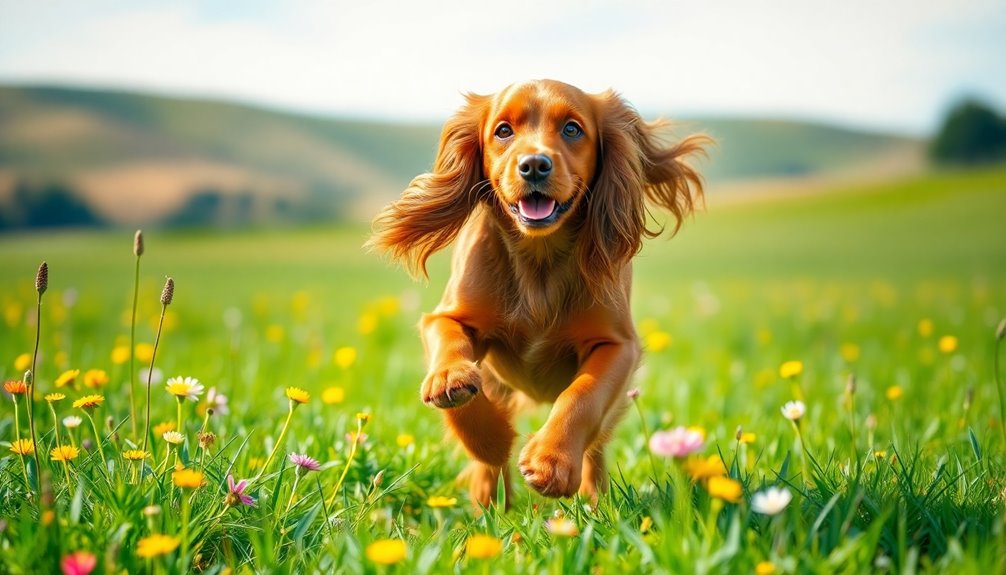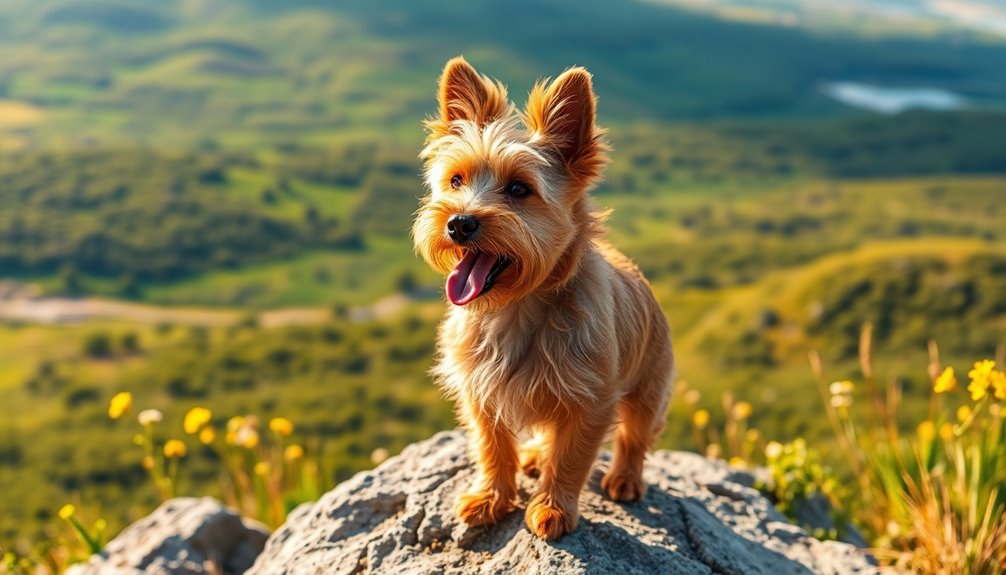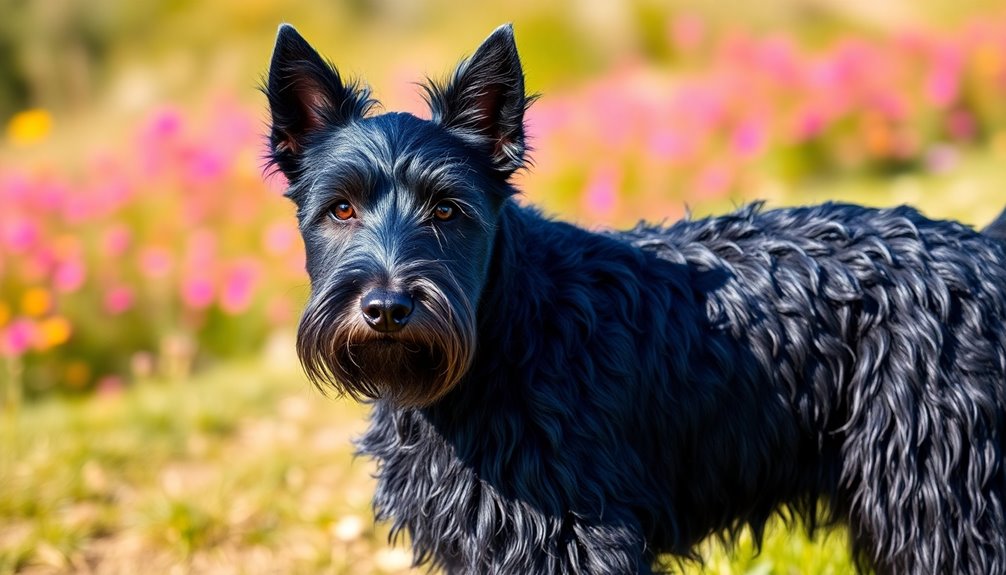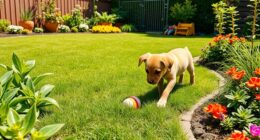Australian Shepherds are high-energy, intelligent dogs that need lots of exercise and mental challenges to stay happy. They stand between 18-23 inches tall, with a muscular build and a double-layered coat that comes in various colors. This breed, originally developed for herding, thrives in active environments and forms strong bonds with their families. Regular training and socialization are crucial to keep their playful nature in check. They not only love agility activities but also bond well with children. If you're eager to discover more about caring for these dynamic companions, there's plenty to uncover!
Key Takeaways
- Australian Shepherds are intelligent, high-energy dogs requiring 1-2 hours of daily exercise to maintain their physical and mental well-being.
- They exhibit strong herding instincts and excel in activities like agility, obedience, and herding competitions.
- Regular grooming is necessary due to their medium-length, double-layered coat, which can come in various colors and patterns.
- This breed is known for its friendly demeanor, making them great companions for families and children, but consistent training is essential.
- Australian Shepherds thrive in spacious environments but can adapt to smaller living spaces with adequate exercise and mental stimulation.
Introduction
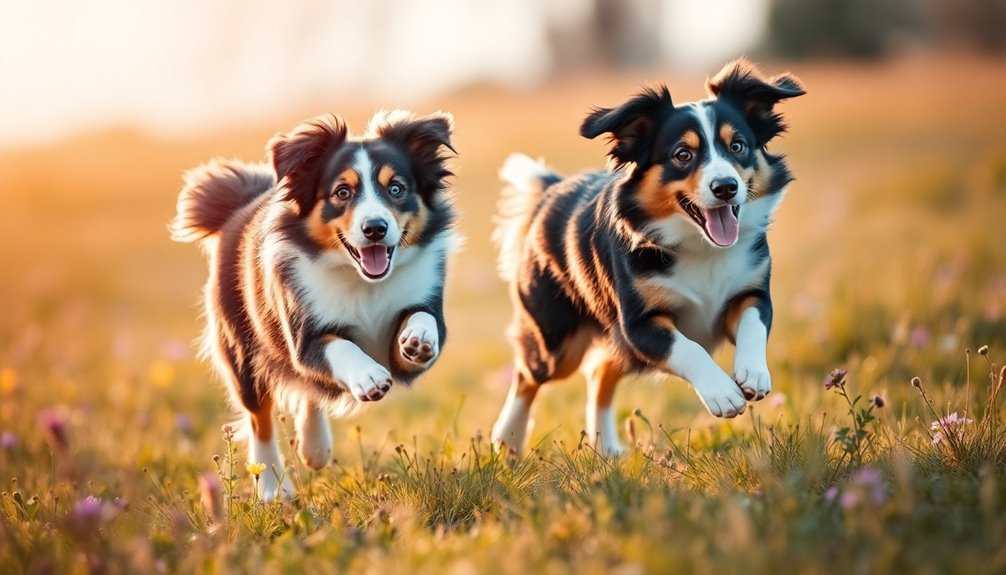
Australian Shepherds are an incredibly versatile breed known for their intelligence and high energy. Standing between 18 to 23 inches tall and weighing 40 to 65 pounds, they boast a medium-sized, athletic, and muscular build. Their medium-length, double-layered coat isn't only water-resistant but comes in stunning colors like black, red, blue merle, and red merle, often featuring white and tan markings.
These dogs are highly intelligent and incredibly eager to please, making them easy to train. However, their high energy needs mean they require at least 1-2 hours of strenuous activity daily to stay happy and healthy. They thrive in active families, showing a high compatibility with children, while their social nature ensures they need plenty of interaction.
Although they may be wary of strangers, their protectiveness makes them excellent family pets. With medium grooming needs and moderate shedding, you'll want to brush them regularly, especially during shedding seasons.
Keep in mind they can adapt to city living, provided they've access to outdoor activities. Overall, Australian Shepherds make fantastic companions for those ready to engage with their energetic spirit.
History and Origin
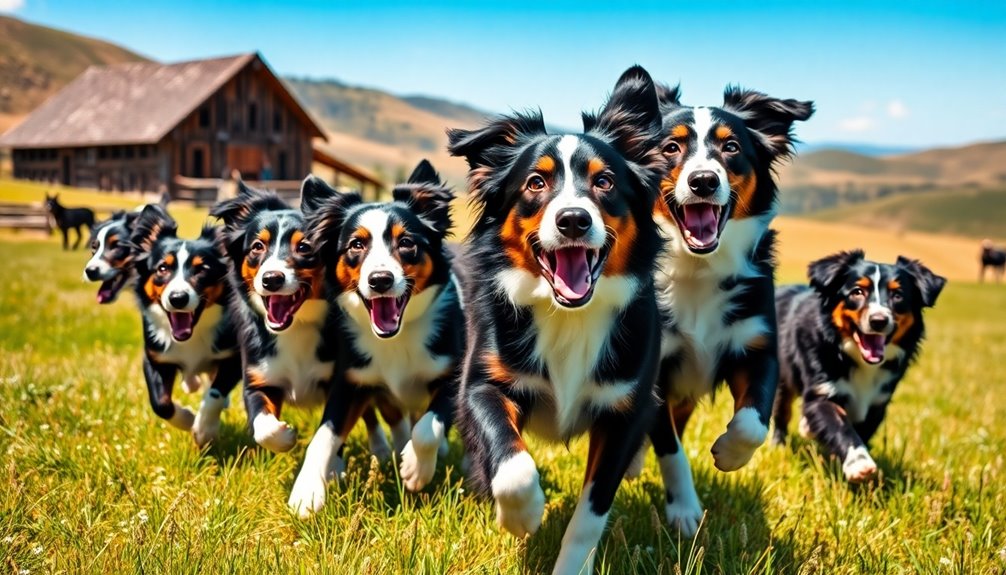
The Australian Shepherd actually originated in the United States, not Australia, with roots tracing back to sheepdog breeds from northwest Spain.
You'll find that these dogs were developed mainly for herding livestock in open fields, showcasing their intelligence and adaptability. The breed's working ability was prioritized over appearance during its development.
As you explore their history, you'll discover how they became an integral part of cowboy culture in the American West.
Where and when the breed originated
Originating in the rugged landscapes of the western United States during the 19th century, Australian Shepherds embody the spirit of hardworking ranch dogs. Developed primarily in California, these dogs were bred to assist farmers and ranchers in herding livestock. Their name stems from the herding dogs brought over from Australia and New Zealand, which were initially imported to work with sheep.
The breed's development involved various herding dogs, including those from Spanish and British origins. Ancestral connections to breeds like the Carea Leonés and the Basque Shepherd Dog are significant, as Basque immigrants arrived during the Gold Rush era, bringing their herding expertise and possibly their own dogs.
The blending of these influences gave Australian Shepherds their remarkable versatility and strong work ethic. Additionally, they are recognized for their exceptional herding abilities, which continues to benefit livestock management today.
While they started as dedicated herding dogs, their charm and intelligence led to their rise in popularity as companion animals. By the late 20th century, Australian Shepherds had solidified their place in homes and dog shows alike, showcasing the unique combination of heritage and hard work that defines this vibrant breed.
Herding Livestock in Open Fields
Herding livestock in open fields showcases the remarkable skills that Australian Shepherds have honed over generations.
These dogs possess a strong herding instinct embedded in their genetic makeup, allowing them to excel in guiding and managing livestock. Their intense gaze, known as "eye," combined with a crouched "stalk," lets them effectively control and direct animals. You'll notice their nipping at heels and barking to encourage movement, while they naturally circle and gather herds to keep them together.
Australian Shepherds are agile, making quick, precise movements essential for navigating diverse terrains. Their stamina enables them to work tirelessly, protecting livestock from predators and guiding them through rough areas. Strong bonds with owners enhance their herding effectiveness, contributing to the breed's suitability for active lifestyles.
To become effective herders, training should begin early, focusing on specific commands like "come by" and "away to me." Consistent practice enhances their responsiveness and skill.
Ultimately, these dogs play a crucial role in managing livestock, moving herds to grazing sites, and ensuring their safety. Engaging in herding not only fulfills their instincts but also provides the mental stimulation necessary for a healthy, happy Australian Shepherd.
Physical Characteristics
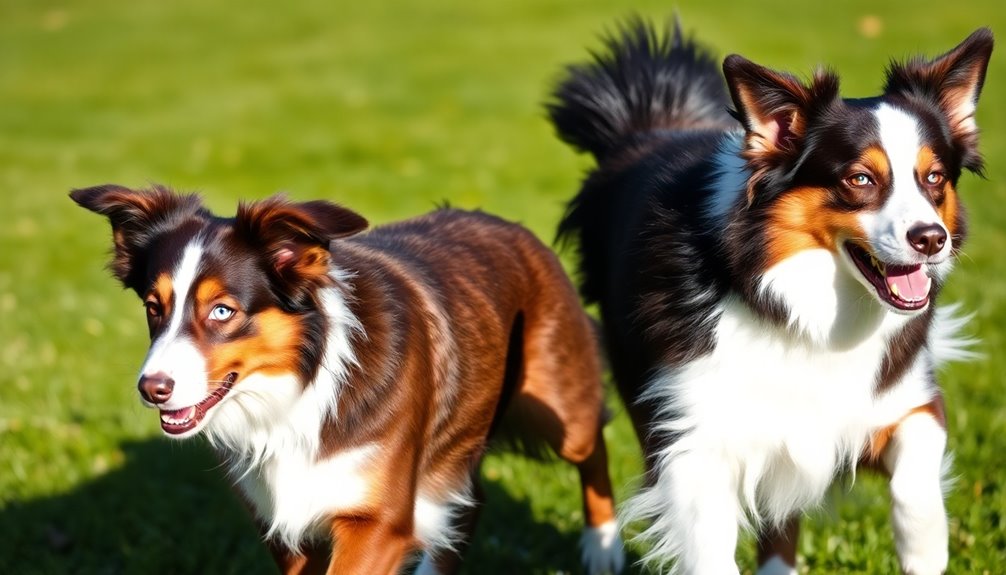
Australian Shepherds are medium-sized dogs, with males standing 20-23 inches tall and weighing between 50-65 pounds, while females are slightly smaller at 18-21 inches and 40-55 pounds.
Their medium-length, double-layer coat can be straight or wavy and comes in various colors, including black, red, and merle. Color variations include red merle and blue merle, which showcase their striking appearance.
You'll also notice unique merle coat patterns, which can feature stunning variations like tweed and harlequin.
Size, weight, and coat details
When you think of the Australian Shepherd, you picture a medium-sized, athletic dog that's built for action. Males typically stand between 20 to 23 inches tall at the shoulder, while females range from 18 to 21 inches. Males usually weigh between 50 to 65 pounds, and females weigh about 40 to 55 pounds, with some lighter females coming in as low as 35 pounds.
These dogs have a lean, muscular build that reflects their energetic nature. Their medium-length coat is slightly wavy and features a thick, weather-resistant undercoat, which means regular brushing is essential to keep it in good shape. Adequate nutrition is crucial to support their growth and maintain their athletic physique.
You'll find Australian Shepherds in various colors, including shades of red, blue, and black, often adorned with white markings and tan points around the face, chest, and legs.
Their robust and well-balanced appearance, combined with a short tail—some are even born tailless—adds to their unique charm. Overall, the Australian Shepherd's size, weight, and coat contribute to its striking presence and suitability for an active lifestyle.
Merle Coat Color Variations
Merle coat color variations add stunning visual appeal to the Australian Shepherd, showcasing a unique blend of colors and patterns. You'll find two primary types of merle coats: red and blue.
Red merle Australian Shepherds feature a marbled effect with a rich red base. There are three variations: solid red merle, red merle bicolor, and red merle tricolor, often adorned with patches of white and copper. Their striking eyes can be solid amber, blue, or a mix, enhancing their distinctive look.
On the other hand, blue merle Australian Shepherds have a black base intertwined with silver or white, creating a slate-blue appearance from a distance. Similar to red merles, they also come in solid, bicolor, and tricolor variations, with the pattern ranging from light to dark. This unique marbling effect is highly sought after in breeding for their striking visuals.
The eyes of merle coats can be blue, amber, or brown, sometimes featuring marbled or flecked patterns. Additionally, you'll encounter rarer patterns like tweed and harlequin, which introduce further color diversity.
While some of these variations may not meet breed standards, they contribute to the Australian Shepherd's genetic richness and visual charm.
Temperament and Personality
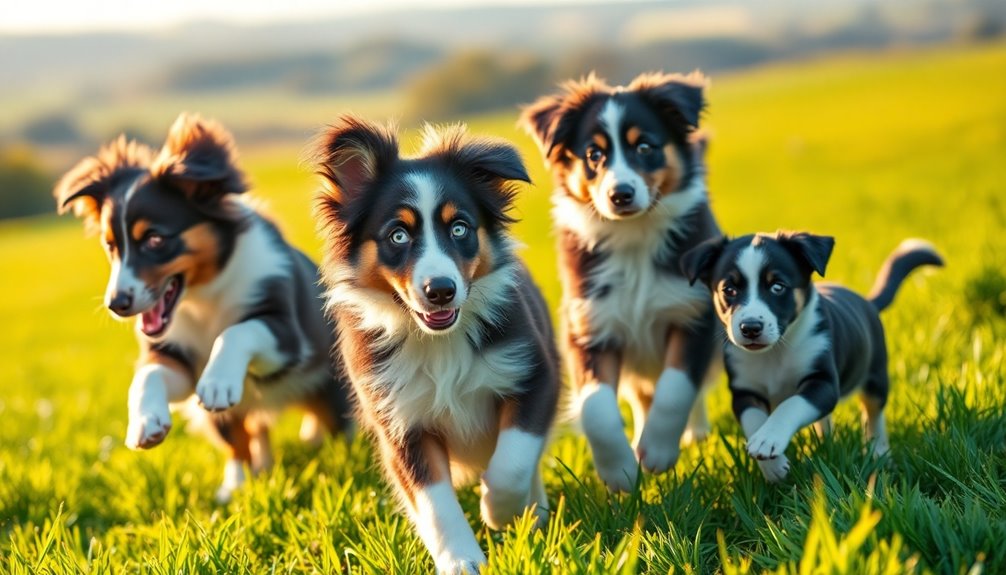
Australian Shepherds are known for their playful and intelligent demeanor, making them a joy to have around. Whether you're a family, an individual, or have other pets, these dogs can adapt well to your lifestyle. Their loyalty and energy ensure they fit seamlessly into a dynamic home environment. Additionally, their strong herding abilities make them excellent companions for active families and individuals seeking an engaging partner.
Playful and Intelligent Demeanor
One of the most striking features of Australian Shepherds is their playful and intelligent demeanor. These high-energy dogs thrive on physical activity, needing plenty of exercise to stay happy and healthy. Their playful nature keeps them constantly seeking stimulation, and without adequate activity, they can become destructive.
You'll find they excel in various activities like agility, obedience, and herding, making them perfect companions for active individuals. Their intelligence is impressive, ranking among the smartest dog breeds. They're quick learners, eager to please, and easy to train. Regular exercise is essential for preventing behavioral problems and managing their high energy levels.
You'll likely notice that they can learn through observation, picking up new commands and tricks rapidly. This trainability makes them a joy to work with in obedience and agility training.
Australian Shepherds are loyal and devoted, forming strong bonds with their families. They thrive on human companionship and can become clingy, seeking attention and interaction.
While they're typically outgoing and friendly, some may be shy around strangers, emphasizing the need for early socialization. This blend of playfulness and intelligence creates a dynamic and engaging personality, making them a wonderful addition to an active household.
Suitability for families, individuals, or other pets
When considering a dog for your family or as a personal companion, Australian Shepherds shine with their friendly temperament and strong desire to bond with people.
They're known for being excellent with children, earning a 5 out of 5 rating for kid-friendliness by the American Kennel Club. Their sturdy build minimizes injury risks during playful interactions, but early socialization is crucial to manage their natural herding instincts. Socialization from puppyhood ensures they develop positive interactions with children, making them even more adaptable within family dynamics. Additionally, supporting a partner ready for parenthood can help families prepare for the responsibilities of pet ownership.
For families, these dogs thrive on companionship and can form strong bonds with every member, from kids to seniors.
However, they require consistent training and attention to prevent unruly behavior. If you're an active individual, Australian Shepherds make great companions, needing regular exercise and mental stimulation to stay happy and engaged.
They're highly trainable and love learning new tricks, but without enough stimulation, they may become destructive.
While they're not entirely independent, they can be left alone for short periods.
With the right training and engagement, Australian Shepherds can flourish in both family settings and as individual pets, adapting well to your lifestyle while providing loyal companionship.
Health and Lifespan
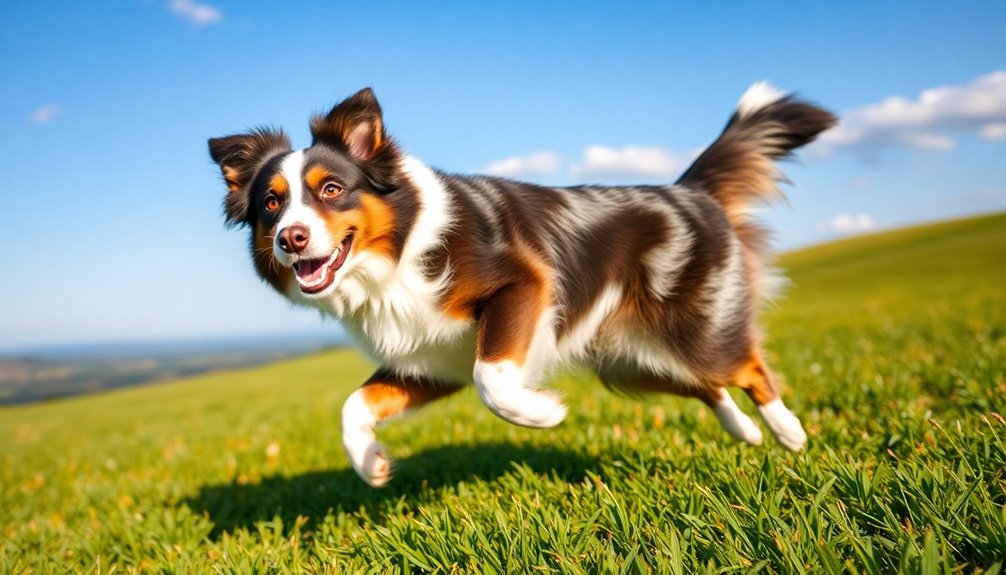
When it comes to your Australian Shepherd's health and lifespan, you can expect them to live between 12 to 15 years with proper care. However, be aware of common health concerns like hip dysplasia and epilepsy that can affect this breed. Additionally, the breed is also prone to the MDR1 mutation, which can lead to serious health complications if not managed properly.
Typical lifespan of the breed
Australian Shepherds typically enjoy a lifespan of 12 to 15 years, which is quite impressive for a medium-sized breed. While it's rare, some individuals have been known to reach up to 18 years. This longevity places them near the upper limit compared to other purebred dogs, which generally live between 8 and 15 years.
When you compare them to larger breeds like Great Danes, Australian Shepherds definitely have the edge. They share a similar lifespan with other medium-sized breeds, such as huskies and Australian cattle dogs. Interestingly, mini Australian Shepherds have a lifespan comparable to their full-sized counterparts, typically falling within the same 12 to 15-year range.
Several factors can influence your Australian Shepherd's lifespan. Genetics play a crucial role, but you can also impact their longevity through diet and exercise. A balanced diet, regular activity, and routine veterinary care help maintain their health. Regular veterinary check-ups are recommended to enhance longevity.
Additionally, you'll find that female Australian Shepherds tend to outlive males by about six months. Remember, good care and a healthy lifestyle are key to ensuring your furry friend lives a long and happy life.
Common health concerns or genetic predispositions
While Australian Shepherds are known for their impressive lifespan, they do face several common health concerns and genetic predispositions that potential owners should be aware of.
One significant issue is epilepsy, which can cause seizures starting before the age of three. Additionally, conditions like Neuronal Ceroid Lipofuscinosis 8 (NCL 8) and degenerative myelopathy may also arise. Anxiety is common in this breed, leading to various behavioral challenges.
Musculoskeletal issues, such as hip and elbow dysplasia, can affect their mobility. Cruciate ligament ruptures and patellar luxation are other potential concerns. Hip dysplasia is a prevalent issue affecting joint mobility and can lead to arthritis.
Eye problems like cataracts, collie eye anomaly, and distichiasis can impair vision and cause discomfort.
Australian Shepherds are also prone to skin allergies and other conditions like Multiple Drug Sensitivity (MDR1), which affects their response to certain medications.
Hemangiosarcoma and lymphoma are cancers more frequently seen in this breed, alongside various autoimmune diseases and umbilical hernias.
Being aware of these health risks can help you provide the best care for your Australian Shepherd, ensuring they lead a vibrant and active life.
Tips for maintaining health and wellness
To ensure your Australian Shepherd remains healthy and thrives throughout their life, prioritizing regular veterinary care, a balanced diet, and ample exercise is essential.
Schedule yearly check-ups for physical exams, vaccinations, and tests to catch health issues early. Don't forget eye exams by a specialized vet, as early detection can prevent serious problems. Discuss your dog's diet, exercise needs, and any behavior changes with your vet. It's also important to consider genetic testing for common health issues like hip dysplasia and PRA, as this can help you make informed decisions about breeding and care.
A nutritious diet tailored to your dog's age, weight, and activity level is crucial. Opt for high-quality dog food with real meat, avoiding fillers or by-products. Keep an eye on portion sizes to maintain a healthy weight and prevent obesity.
Your Australian Shepherd needs 1 to 2 hours of exercise daily, broken into sessions. Engage them in activities like running, agility training, or playing fetch. Variety keeps their routine exciting!
Always warm them up before intense exercise and provide water breaks, especially during hot weather.
Regular grooming, mental stimulation through training games, and ensuring fresh water is always available are vital for overall wellness.
Together, these practices significantly impact your dog's lifespan and quality of life.
Care Requirements

Caring for your Australian Shepherd means meeting their unique needs for grooming, exercise, and nutrition.
You'll need to brush their coat regularly to keep it healthy, while ensuring they get plenty of physical activity to match their high energy levels. Additionally, be aware that they have high exercise needs which require daily activities to keep them physically and mentally stimulated.
Plus, feeding them a balanced diet is essential for their overall well-being.
Regular Brushing Required
Regular brushing is essential for Australian Shepherds to keep their coats healthy and looking great. You should brush your dog's coat 2-3 times a week to prevent matting and manage shedding. During shedding seasons in spring and fall, increase the frequency to daily sessions. This regular brushing helps remove loose hair, prevents tangles, and keeps the coat in top condition. Additionally, be aware that Australian Shepherds are heavy shedders, making frequent brushing necessary to manage loose hair effectively.
To effectively groom your Australian Shepherd, use a slicker brush for the outer coat to tackle tangles and mats. An undercoat rake is crucial for getting rid of loose underfur, while a pin brush can help remove loose fur before using the slicker brush. Metal combs and deshedding tools can also be handy in your grooming kit. Remember to be gentle to avoid skin irritation.
In addition to brushing, you'll want to trim your dog's nails every 2-3 weeks, clean their ears weekly, and brush their teeth several times a week for overall hygiene.
While bathing is important, avoid doing it too frequently—every 6-8 weeks should suffice. By following these grooming practices, you'll help ensure your Australian Shepherd stays comfortable and looking fabulous.
Exercise requirements and energy levels
Australian Shepherds are incredibly active dogs that thrive on daily exercise, requiring at least 1-2 hours each day to keep their energy levels balanced. To meet their needs, you should split exercise into multiple sessions.
Daily walks and vigorous playtime are essential for their physical and mental well-being. Activities like fetch, jogging, and agility training are highly recommended to keep them engaged. Regular exercise supports blood flow, metabolism, and heart health, helping to prevent obesity and boredom-induced behaviors.
Incorporate long-distance hikes and runs to help burn off their high energy levels. Try participating in dog sports such as agility, flyball, and obedience training, which offer both physical and mental stimulation. A fenced yard where they can run freely is also important for their happiness.
For Australian Shepherd puppies, start with short walks (5 minutes for each month of age) and gradually increase the duration as they mature. Avoid long-distance runs until they're at least 12-15 months old.
Adult Aussies require more intense and varied exercise routines, so adjust based on your dog's individual energy levels and health. Remember, consistent training and exposure to different environments are crucial for their overall development and well-being.
Feeding tips and diet recommendations
Meeting the exercise needs of your Australian Shepherd is just one part of their care; nutrition plays an equally important role in their overall health and well-being. To keep your pup thriving, aim for a diet rich in high-quality proteins, healthy fats, and complex carbohydrates. Ensuring that your dog receives a diet with high energy levels is essential to support their active lifestyle.
For puppies, ensure their food contains 25-30% protein and 12-16% fat, while adults need about 25% protein and 12% fat. Seniors should have slightly less, with 18-20% protein and 10% fat.
Feed puppies four meals a day until three months, then transition to three. Adults typically do best with two meals a day, spaced 12 hours apart, while seniors may continue with two unless your vet advises otherwise.
Portion sizes vary: puppies need 1-4 cups, adults require 8-10 cups, and seniors generally get 2-3 cups daily.
It's crucial to monitor your dog's weight and adjust portions to prevent obesity. If you notice specific health concerns or dietary sensitivities, consult your veterinarian for tailored advice.
Training and Socialization
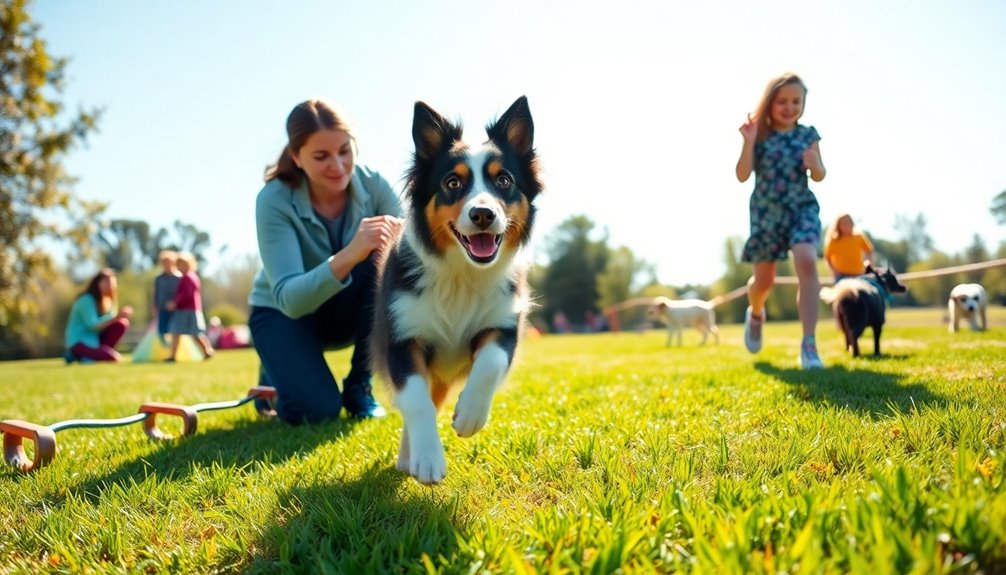
Training your Australian Shepherd is a rewarding experience, especially when you stay consistent with your methods. Gradually introducing your pup to new friends helps build their confidence and reduce any potential separation anxiety. Incorporating agility exercises can also enhance their physical and mental stimulation, making training sessions even more engaging and enjoyable.
Highly Trainable With Consistency
With a consistent approach to training and socialization, you'll find Australian Shepherds to be highly trainable and eager learners.
Keep your training sessions short—around 5 to 10 minutes—to maintain their focus and energy. Aim for daily sessions whenever possible, and choose a quiet environment with minimal distractions to optimize learning. Always end on a positive note to reinforce good behavior.
Using positive reinforcement techniques is essential. Reward your Aussie with praise, treats, or toys for good behavior, and avoid harsh corrections, as they can be counterproductive.
Consistency is key, so make sure all family members use the same commands and provide similar rewards. Well-socialized dogs are less likely to exhibit aggression towards unfamiliar people or animals, fostering positive relationships.
Socialization should start early, ideally between 3 to 14 weeks. Gradually expose your pup to various environments, sounds, and experiences, ensuring they interact positively with people of all ages and sizes.
Consider enrolling in puppy classes and organizing safe playdates with well-behaved dogs.
Gradual Introductions to New Friends
Introducing your Australian Shepherd to new friends and environments is a vital step in their development. The critical socialization period, from 3 to 14 weeks, is the perfect time to help your pup form positive associations with new experiences. Delaying this process can lead to fear or aggression, so it's essential to get started early.
Begin with gradual exposures. Introduce your pup to new sounds, sights, and environments without overwhelming them. Start with short, supervised interactions and gradually increase the complexity and duration. This approach helps prevent anxiety and fosters confidence. Australian Shepherds are known for their high energy levels, so it's important to ensure they are engaged during these interactions.
Use positive reinforcement to reward calm behavior. Treats, praise, and affection can help your Australian Shepherd associate new experiences with positivity. Reward them for friendly interactions and consistent good behavior around other pets and people.
Organize controlled play sessions with well-behaved dogs, and consider enrolling your puppy in socialization classes. Arrange playdates with various people and pets, ensuring you supervise closely.
Pay attention to your pup's body language, and respect their limits to make each encounter a pleasant experience. This careful approach will set the stage for a well-adjusted and sociable adult dog.
Separation Anxiety Issues
Even as you focus on socializing your Australian Shepherd with new friends and environments, it's equally important to address potential separation anxiety issues.
These dogs form strong bonds with their owners, making them prone to anxiety when left alone. Changes in your routine or environment, like moving or a new work schedule, can trigger this anxiety. Effective co-parenting plans are essential to ensure that your dog receives consistent care during transitional periods.
You might notice signs such as destructive behavior, excessive barking, or even bathroom accidents when you prepare to leave. To help your pup cope, consider using training methods like counterconditioning, where you reward calm behavior during your departure routine.
Desensitization can also be effective; gradually expose your dog to your leaving cues without actually departing. Increasing daily exercise can also significantly help alleviate anxiety by providing mental challenges and social interactions.
Providing regular exercise and mental stimulation is crucial. Daily walks, play sessions, and training can keep your dog engaged and reduce anxiety.
Establish a safe space for them to retreat to when feeling anxious, and maintain consistent training to foster trust.
If separation anxiety persists, don't hesitate to seek professional help from a veterinarian or a certified animal behaviorist.
These strategies will help your Australian Shepherd feel more secure and content when you're away.
Ideal Living Environment
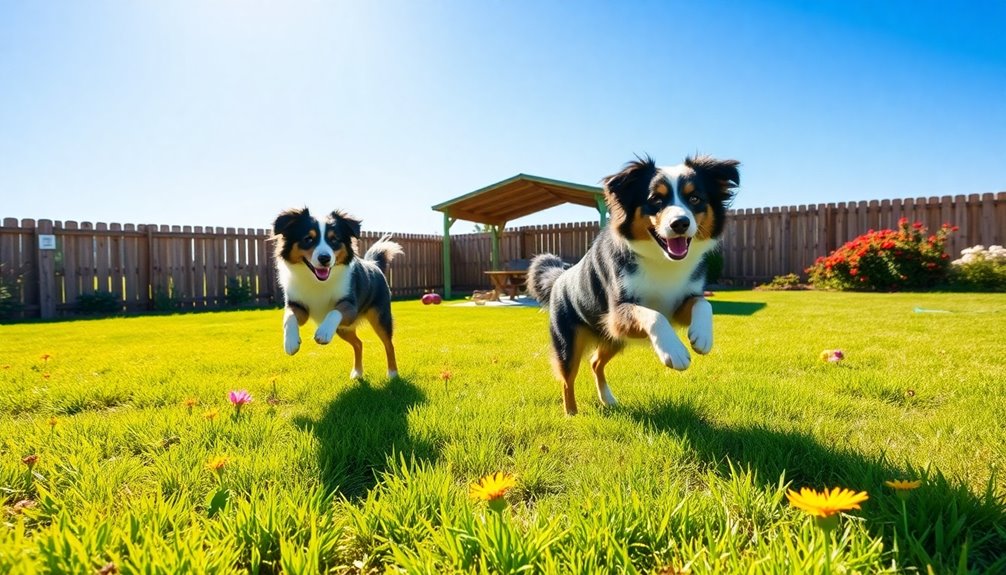
For an Australian Shepherd, a spacious backyard is essential for plenty of playtime and exercise. They thrive in warm, temperate climates where they can enjoy the outdoors year-round. Additionally, providing regular high energy levels exercise is crucial for their overall well-being and happiness.
Spacious Backyard for Playtime
A spacious backyard offers the perfect environment for your Australian Shepherd to thrive, providing ample space for both playtime and exercise.
To keep your energetic pup safe, high, secure fencing is essential. These dogs can leap several feet into the air, so standard fences often won't keep them contained. Strong fencing helps manage their herding instincts, preventing them from chasing after pets or children outside the yard.
Australian Shepherds require at least two hours of exercise daily, and a large, fenced yard is ideal for them to run and play. Activities like fetch or agility training can help them burn off energy while keeping them physically fit. Additionally, these dogs are known for their high energy levels, which means they thrive in environments that allow for vigorous activity.
Mental stimulation is just as important; interactive toys and games can challenge their minds and prevent boredom.
While a spacious backyard is optimal, remember that these dogs can adapt to apartment living if you provide enough exercise and enrichment.
Regular walks and consistent companionship are crucial for their happiness.
With the right environment and care, your Australian Shepherd will flourish, enjoying both physical and mental activities that keep them engaged and healthy.
Warm, Temperate Climate Preference
Australian Shepherds thrive best in warm, temperate climates, where their double coat offers natural insulation against both cool and moderate heat. While they can adapt to various conditions, you'll find they perform best in environments that aren't extreme.
In hot weather, it's crucial to manage their activity levels to prevent overheating. Make sure they've access to shaded areas and plenty of fresh water, especially during peak heat hours.
In colder climates, their double coat helps them tolerate chilly temperatures, but they're not immune to extreme cold. You should limit their exposure to severe conditions and consider using dog coats or sweaters when necessary. It is also important to provide shelter and warmth during winter to enhance their comfort and safety.
Keeping them indoors during harsh weather can also help maintain their comfort.
Regardless of the climate, regular grooming is essential to keep their coat healthy and prevent matting. Additionally, provide an enclosed outdoor space for safe play, as these energetic dogs require plenty of exercise.
With the right care and environment, you can ensure your Australian Shepherd thrives and remains happy, regardless of the weather.
Talented Herding Competitors
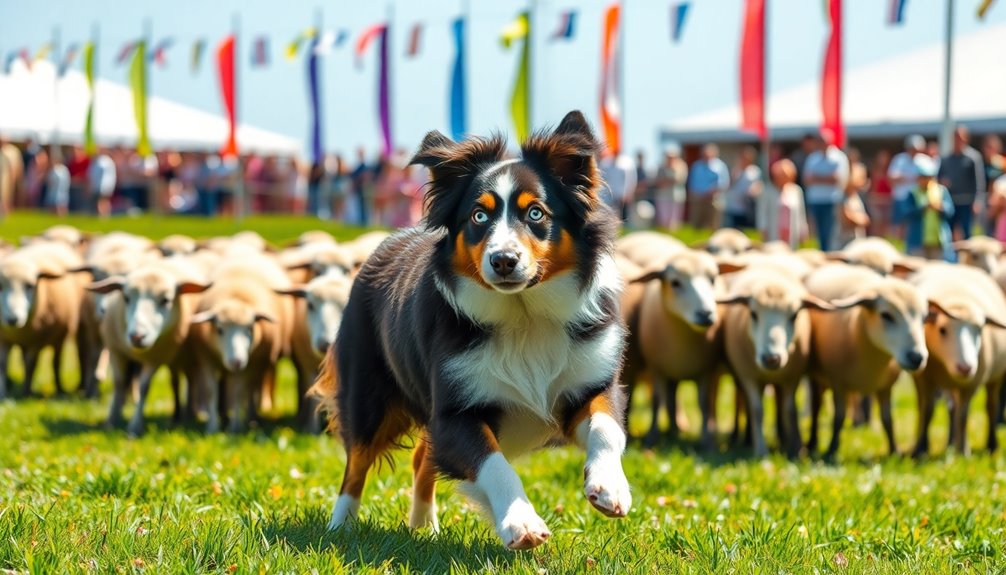
Australian Shepherds aren't just skilled herders; they also possess remarkable intuitive problem-solving abilities that shine in competitive settings. You might even recognize these talented dogs from the beloved film 'Babe', showcasing their herding prowess on screen. Their agility and intelligence make them stand out in herding trials, where teamwork between dog and handler is essential. In these trials, dogs compete in various test levels, such as started, intermediate, advanced to demonstrate their herding skills.
Intuitive Problem-Solving Abilities
With their remarkable problem-solving abilities, these intelligent dogs excel in herding scenarios. Australian Shepherds can quickly assess situations, predict livestock movements, and adapt their herding techniques accordingly. This keen intelligence is crucial, enabling them to navigate complex environments effectively.
Their independent thinking and decision-making skills shine as they react swiftly to changing circumstances. You'll notice how they can troubleshoot obstacles, whether it's finding alternate routes around fences or identifying the best way to guide animals. This adaptability is essential in dynamic herding conditions.
Moreover, their visual sensitivity enhances their herding instincts. They react to movements that other breeds might overlook. This sensitivity can lead to instinctual behaviors like nipping and circling, especially with fast-moving objects. Therefore, it's vital to channel this energy into appropriate activities. Understanding individual dog temperamental changes during growth is also important in developing their herding skills and overall behavior.
To keep your Australian Shepherd mentally sharp, provide ample mental stimulation through dog sports, puzzles, and problem-solving games. Engaging their minds is just as important as physical exercise. If they don't get enough stimulation, they might resort to undesirable behaviors.
Structured training helps guide their independent spirit while curbing any potential issues.
Famous in 'Babe' Film
Often celebrated for their herding prowess, Australian Shepherds gained widespread fame through their role in the beloved film "Babe." This movie showcased their exceptional skills and highlighted the breed's intelligence and agility.
Your Australian Shepherd's deeply ingrained herding instincts make them natural competitors. They instinctively nip and push against other animals, showcasing their strong work ethic and athleticism.
In competitive herding, these dogs thrive in AKC Herding Trials, where their abilities shine across various test levels and course types. You can train your Australian Shepherd to respond to specific commands, enhancing their herding performance. Their success relies on teamwork between you and your dog, emphasizing the importance of obedience training before tackling herding exercises. Training focuses on specific herding tasks and commands to ensure your dog is well-prepared for various challenges in competition.
Preparing for herding competitions often involves professional guidance due to the breed's intelligence and potential stubbornness. Initial training includes the "Instinct Test," evaluating your dog's basic herding instincts.
By engaging in these activities, you not only develop their skills but also provide essential mental stimulation.
Whether in a pasture or an urban setting, your Australian Shepherd's herding instincts can be nurtured, allowing them to shine just like the talented competitors in "Babe."
Active Lifestyle Compatibility
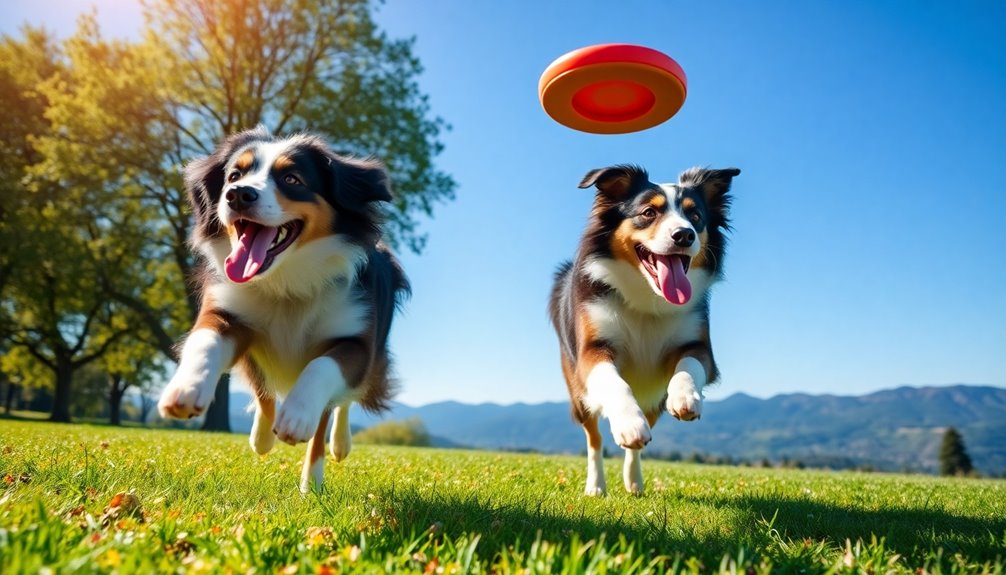
Active Lifestyle Compatibility
If you lead an active lifestyle, an Australian Shepherd could be the perfect companion for you. These dogs thrive on physical activities and require a solid time commitment for training and exercise. With their energy and intelligence, they'll keep you on your toes while enjoying every moment spent together. Regular exercise is essential for their mental and physical well-being.
Ideal for Active Individuals
Energetic companionship defines the bond you'll find with an Australian Shepherd, making them an ideal match for active individuals. If you love outdoor adventures, this breed thrives alongside you.
With a daily requirement of 1–2 hours of exercise, they're perfect for vigorous dog sports, long hikes, or spirited games of fetch. Engaging them in agility, flyball, or obedience training not only keeps them physically fit but also provides the mental stimulation they crave.
Living in a spacious home with a secure, fenced yard is crucial, as these dogs need room to run and play freely. Apartment living isn't suitable for their high energy levels. Additionally, regular exercise helps mitigate health issues related to their active nature.
If you enjoy running, hiking, or frequent trips to the park, your Australian Shepherd will be your loyal companion every step of the way. They're affectionate and often get along well with children, although they might exhibit some herding instincts.
To ensure a happy and well-balanced life with your Australian Shepherd, be prepared to commit to an active lifestyle. Regular exercise is essential for preventing boredom and potential destructive behavior, keeping your furry friend safe and engaged.
Time Commitment for Training
To fully harness the potential of an Australian Shepherd, a dedicated time commitment for training is necessary. Start early by teaching basic cues like sit, down, and leash manners during the 8–16 week growth stage. Consistency is crucial, so ensure all family members agree on rules to avoid confusion. Regular training sessions will keep your dog engaged and mentally stimulated.
Adult Australian Shepherds need at least 1–2 hours of exercise daily, which can include walks, jogs, fetch, or dog sports. For puppies, gradually increase exercise duration, limiting an 8-week-old to just 10 minutes a day. Avoid long-distance runs until they're older to protect their joints. The breed's high energy levels necessitate a significant commitment to exercise and playtime.
Incorporate mental stimulation through interactive toys and problem-solving activities, like learning new tricks or participating in group training routines. This not only challenges their intelligence but also strengthens the bond between you and your dog.
Ultimately, you'll need a flexible schedule to accommodate your Aussie's needs. If you can commit time to training and exercise, you'll enjoy a rewarding partnership with this energetic breed.
Frequently Asked Questions
Are Australian Shepherds Good With Children and Other Pets?
Yes, Australian Shepherds can be great with children and other pets!
They're patient and protective, forming strong bonds with family members. Their high energy levels make them playful companions, perfect for active kids.
However, you'll need to supervise interactions, especially since their herding instincts might kick in.
With proper training and socialization, they can learn to respect boundaries and coexist happily with everyone in the household, including other pets.
How Much Exercise Do Australian Shepherds Need Daily?
If you're wondering how much exercise your dog needs daily, aim for at least 1-2 hours.
You can mix activities like walks, runs, and playtime to keep things interesting.
Don't forget to include both indoor and outdoor exercises to stimulate their mind and body.
For puppies, gradually increase their exercise based on their age, ensuring it's appropriate for their development.
Consistent activity is key for maintaining your dog's health and happiness.
Do Australian Shepherds Shed a Lot?
Yes, Australian Shepherds do shed a lot, especially during certain times of the year.
You'll notice heavy shedding in spring and fall as they blow their coats to adapt to changing temperatures.
While they shed moderately year-round, daily brushing during these peak seasons is essential to control the loose fur.
Regular grooming can help manage shedding and keep your home cleaner, so make it a part of your routine!
What Are Common Behavioral Issues in Australian Shepherds?
Common behavioral issues you might encounter include fearfulness from past trauma, aggression stemming from insecurity, and separation anxiety leading to destructive behaviors.
Excessive barking can signal anxiety or boredom, while herding instincts may prompt chasing or nipping at people or objects.
Without proper training and mental stimulation, these behaviors can escalate.
It's essential to address these issues through professional training, consistent exercise, and engaging mental activities to ensure a well-adjusted companion.
How Can I Keep My Australian Shepherd Mentally Stimulated?
To keep your dog mentally stimulated, engage in daily training sessions lasting 5-10 minutes.
Incorporate puzzle toys and interactive games, like hide and seek with treats. Regularly teach new tricks to challenge their mind. Agility training can also enhance both physical and mental skills.
Rotate toys to keep things fresh and avoid boredom.
Lastly, ensure plenty of socialization with other dogs and people to enrich their experiences and maintain their happiness.
Conclusion
In conclusion, Australian Shepherds make fantastic companions for those who lead active lifestyles. Their intelligence, energy, and eagerness to please create a bond that's hard to beat. With proper training, socialization, and an engaging environment, you'll find that they thrive in a home where they can run, play, and work. If you're ready to embrace the lively spirit of this breed, you'll gain a loyal friend who'll keep you on your toes every day!

